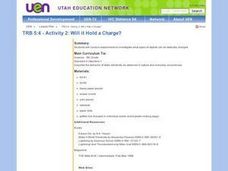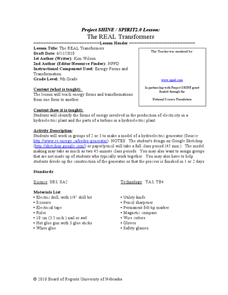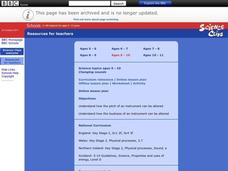Curated OER
Transformation of Energy-8th Grade
Eighth graders examine how electricity is produced in relation to the atom as well as what causes electric current to flow and what determines how much current flows through a circuit. These and other concepts of transformation of energy...
Curated OER
Will it Hold A Charge?
Fifth graders discuss which materials they believe hold an electric charge. In groups, they experiment with different objects and charging them. They discuss their results after the activity.
Curated OER
Making A Compass
This interesting science instructional activity is about the compass. Students make a compass out of a magnet, sewing needle, cork, and a glass dish. The instructional activity includes both a pre and post-test for the students to take,...
Curated OER
Hot Stuff
Students investigate mechanical and electrical machines in the classroom and school, and identify which produce heat while operating.
Curated OER
Energy Is Everywhere
Students determine the difference between renewable and non-renewable resources and identify the different forms of energy. They discuss life without energy and where energy comes from before reading an article about the different...
Curated OER
The REAL Transformers
Ninth graders create a model of a hydroelectric generator. In this physics lesson, 9th graders discuss how energy can be transformed from one form to another. They make a flow chart for different energy generating plants.
Curated OER
Nuclear Waste
Students identify pros and cons of nuclear power, and analyze problems surrounding nuclear waste and how to make decisions regarding its disposal.
Curated OER
Solar Photovoltaic (PV) Kit
The National Energy Foundation presents this activity, which instructs students to follow directions to connect a solar electric panel to a buzzer. They charge the solar panel to cause the buzzer to sound. The process is repeated with a...
Curated OER
Energy Efficiency: It really IS important!
Students compare the energy needed to produce new products versus recycling. In this physics lesson, students brainstorm ways to save energy. They create a presentation about the correlation between conserving energy and energy costs.
Curated OER
Energy Conservation
Class is divided into groups of 2-4 students. They then are given a list of 36 items that are found in our homes and which use electricity. They are going to pretend that because of an energy shortage, they have to pick only twelve items...
Curated OER
Changing circuits
Students identify that there are conventional symbols to represent the components in circuits. Students use these symbols to draw diagrams of circuits. They are reminded that electric circuits can be drawn in diagrams using symbols. ...
Curated OER
Changing Circuits
Students observe an on-line activity to review the basics of electrical circuitry, then research answers to related questions on-line.In this lesson on changing components in a series circuit, students discover how different components...
Curated OER
Plants and Animals in the Local Environment
Students recognize the different types of plants and animals living in a local environment. They determine how they require different habitats to live, and relate simple life processes to plants and animals found in local environments.
Curated OER
Teaching the Scientific Method Using Adhesives
Learners research on the history of adhesives. In this science instructional activity, students select one test to use in finding the stickiness of adhesives. They collect data and formulate a conclusion.
Curated OER
Changing Sounds
Students identify how the pitch and the loudness of an instrument can be altered. In this online science of sound instructional activity, students employ the use of an interactive whiteboard to examine the loudness and pitch of a guitar,...
Curated OER
Changing State
Students investigate the cooling and heating of water. In this online science experiment lesson, students work in groups to make predictions regarding freezing and boiling points and then test those predictions as they complete the...
Curated OER
How We See Things
Students explain that when a beam of light is reflected from its surface, it changes direction. In this virtual science experiment lesson plan, students complete an activity that requires them to investigate how flat mirrors reflect...
Curated OER
Characteristics of Materials
Students describe and compare common properties of various classroom materials. In this science/matter lesson, students observe common classroom items and the materials they are made of to complete a list of common properties.
Curated OER
Activity #9 Extending Oil Well Production
Middle schoolers simulate methods used to extend the effective life of an oil well by extracting less available oil. They identify techniques which can be used and evaluate their effectiveness. Pupils are introduced to rock size and...
Curated OER
What Can I Do About Global Environmental Change?
Students complete a unit to evaluate their impact on the environment and greenhouse gas emissions. They conduct Internet research, develop a list of their electrical and energy use, calculate their share of greenhouse gases, and identify...
Curated OER
It's About Time
Middle schoolers investigate how Global Positioning Systems work and how and why GPS receivers make errors. They graph data points and apply estimation and prediction to real-life GPS situations, discuss time delay, and complete a...
Curated OER
Lesson 2 of 5 - Energy
Young scholars complete an energy analysis for the No Impact Man project. In this environment and energy lesson plan, students review the project by visiting the given website and discuss the issue of electricity in the project. Young...
Curated OER
Elaine Humphrey, Gwynne Thompson
Second graders become familiar with the parts of the microscope and how it works. In this microscope lesson, 2nd graders experiment with different light and settings. Students answer questions based on their experiment.
Curated OER
The History of Life
In this extinction worksheet, high schoolers review how species evolve and how species go extinct. Students compare and contrast gradualism and punctuated equilibrium. This worksheet has 6 fill in the blank and 4 short answer questions.

























